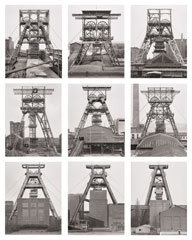Bernd and Hilla Becher
dal 20/5/2008 al 24/8/2008
Segnalato da
20/5/2008
Bernd and Hilla Becher
The Museum of Modern Art - MoMA, New York
Landscape/Typology. Twelve of Bernd and Hilla Becher's "typologies" - rigorous grids of black-and-white photographs showing a single type of industrial structure - are juxtaposed with a selection of their less familiar landscape views of mines, steel mills, and other industrial sites. The exhibition presents these two formats together; because they lie at the polar extremes of photographic description. Curated by Peter Galassi. Focus: Ad Reinhardt and Mark Rothko. The display concentrates on the fertile years between the late 1940s and the early 1960s, during which each artist identified the style and format that would engage him for the rest of his career.

Organized by Peter Galassi, Chief Curator of Photography
The Edward Steichen Photography Galleries, third floor
The German artists Bernd and Hilla Becher, who began working together in 1959 and married in 1961, are best known for their "typologies"—grids of black-and-white photographs of variant examples of a single type of industrial structure. To create these works, the artists traveled to large mines and steel mills, and systematically photographed the major structures, such as the winding towers that haul coal and iron ore to the surface and the blast furnaces that transform the ore into metal. The rigorous frontality of the individual images gives them the simplicity of diagrams, while their density of detail offers encyclopedic richness. At each site the Bechers also created overall landscape views of the entire plant, which set the structures in their context and show how they relate to each other. The typologies emulate the clarity of an engineer's drawing, while the landscapes evoke the experience of a particular place. The exhibition presents these two formats together; because they lie at the polar extremes of photographic description, each underscores the creative potential of the other.
-----
Focus: Ad Reinhardt and Mark Rothko
March 7, 2008 - Ongoing
Organized by Elizabeth Reede, Assistant Curator, Department of Painting and Sculpture.
This installation, drawn from the Museum's collection of paintings by Ad Reinhardt and Mark Rothko, focuses specifically on the fertile years between the late 1940s and the early 1960s, during which each artist identified the style and format that would engage him for the rest of his career. Reinhardt's and Rothko's ideas about form and color challenged and reconsidered European artistic traditions and philosophies, giving rise to a unique American sensibility in art in general, and particularly in painting. Their paintings were characterized not by the grand, expressive gestures and brushwork of their Abstract Expressionist colleagues, including Jackson Pollock and Willem de Kooning, but rather by subtleties in color, form, and composition.
Reinhardt was a prolific writer, and he used the blank page to address many of his ideas about art. The planar surface of the canvas likewise served as support for his experiments and his studies of monochrome palettes, in blue, red, and, ultimately, black, throughout the early 1950s. By mid-decade he had committed to an increasingly nocturnal palette of layered, close-valued, almost indistinguishable colors laid adjacent to one another in a vertical rectilinear format. This exploration of color and symmetry resulted in a trisected three-by-three grid, which developed further in the 1950s and 1960s and concluded in the quietly ordered sub-patterns and homogenous surfaces of his five-foot-square "black" paintings. With prolonged looking, these seemingly all-black surfaces yield colors and hard-edged shapes that shift and slide.
Like Reinhardt, Rothko had a profound interest in internal compositional organization. Also using a tripartite structure, Rothko floated three blurry-edged rectangles atop one another, connecting them as much by the interstitial spaces as by the oscillating shapes. Rothko's oversized, unframed, color-saturated canvases were meant to engage the viewer through envelopment. These large-scale pictures are all encompassing, and their gaseous forms of vibrant color were intentionally placed to pulsate optically and sustain the viewer's attention through physical sensations and constantly changing visual perceptions. Both Reinhardt and Rothko ask viewers to look closely, allow their eyes to adjust, and experience the interior space of the picture.
George Lois: The Esquire Covers
Through March 31, 2009
From 1962 to 1972, George Lois changed the face of magazine
design with his potent, controversial covers for Esquire
magazine. The covers on view at MoMA serve as a visual
timeline and a window onto the turbulent events of
the 1960s.
Check out the online exhibition
for Take your time: Olafur Eliasson - then participate
in the site by wearing a special cell-phone camera as
you explore the show.
Don't miss the final
days of "Design and the Elastic Mind" and "Color Chart: Reinventing Color, 1950 to Today" at
MoMA, and WACK! at P.S.1.
Image: Bernd and Hilla Becher. Winding Towers, Belgium, Germany. 1971–91. Gelatin silver prints, each 15 3/4 x 12 1/8" (40 x 30.8 cm). Lent by Hilla Becher. Courtesy Sonnabend Gallery, New York. © Hilla Becher
The Museum of Modern Art - MoMa
11 West 53 Street New York USA



